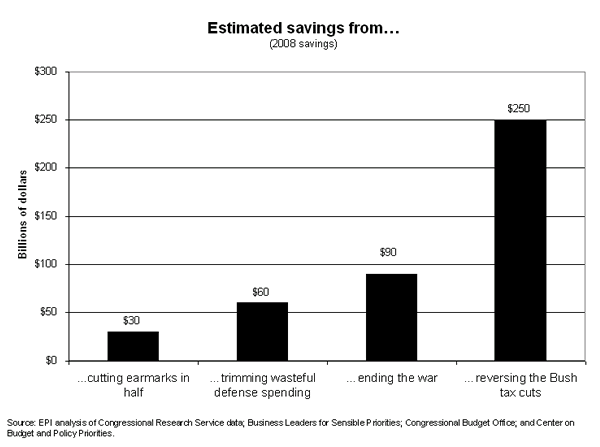See Snapshots archive.
Snapshot for March 21, 2007.
Looking for Savings in All the Wrong Places
As the budget process gets under way, the spotlight will be on earmarks—projects tucked into appropriations or other bills by legislators, often favoring politically connected individuals or businesses in their districts.
According to the Congressional Research Service, the number of earmarks more than tripled between 1994 and 2006. While many of these were for worthy projects, the bribery scandal around former House Appropriations Committee member Randy “Duke” Cunningham highlighted the potential for abuse.
House and Senate committee chairs Rep. David Obey and Sen. Robert Byrd have pledged to cut earmark spending in half and have implemented new disclosure rules. While earmarks merit such scrutiny, they are not a primary cause of the budget deficit, nor even the biggest source of government waste.
The Congressional Research Service identified $67 billion in earmarks in fiscal year 20061 appropriations bills, though many of these—for example, $2.2 billion set aside for veterans’ mental health services and $4.3 billion in aid to Israel and Egypt—would not match most people’s idea of pork-barrel spending.2 Other estimates are much lower.3 In comparison, OMB Watch has found that the number of no-bid government contracts has doubled since 2000, to $97 billion in 2005.4
Experts have noted that the defense budget is stuffed with projects that do nothing to increase national security. Lawrence Korb, an Assistant Secretary of Defense in the Reagan administration, has identified $60 billion in wasteful defense spending, only $5 billion of which comes from earmarks.5 And ending the Iraq war would cut the deficit by almost half,6 based on Congressional Budget Office projections for 2007.7 (See Chart).
Finally, reversing the Bush tax cuts, which are nearly four times the size of the earmarks, would eliminate the budget deficit altogether.8

Notes
1. Fiscal year 2006 is the benchmark because only two appropriations bills were passed the following year.
2. CRS Appropriations Team, “Earmarks in FY2006 Appropriations Acts,” March 6, 2006 Memorandum; and “Earmarks in Appropriations Acts: FY1994, FY1996, FY1998, FY2000, FY2002, FY2004, FY2005,” January 26, 2006 Memorandum. http://www.cdi.org/pdfs/CRS on 2006 earmarks.pdf ,
http://www.fas.org/sgp/crs/misc/m012606.pdf
3. Conservative watchdog group Citizens Against Government Waste puts the 2006 earmark figure at a much lower $29 billion. (Citizens Against Government Waste, 2006 Congressional Pig Book, http://www.cagw.org/site/PageServer?pagename=reports_pigbook2006 )
4. OMB Watch, Federal Contractors: The Invisible, Unaccountable Agency, February 6, 2007.
http://www.ombwatch.org/article/articleview/3711/1/1?TopicID=1
5. Dr. Lawrence Korb, The Korb Report: Realistic Defense for America, Business Leaders for Sensible Priorities, 2006. http://www.sensiblepriorities.org/pdf/korb_report_Finalb.pdf
6. The Congressional Budget Office projected the 2008 cost of military operations and other defense activities in Iraq and Afghanistan at $114-134 billion, depending on whether deployed troops are reduced to 30,000 by 2010 or to 75,000 by 2013. CBO estimates that 75-80 percent of that is for Iraq. (CBO Director Peter R. Orszag, “Estimated Funding for Operations in Iraq and the War on Terrorism,” Letter to Senate Budget Committee Chairman Kent Conrad, February 7, 2007.) http://www.cbo.gov/ftpdocs/77xx/doc7793/02-07-CostOfWar.pdf
7. Congressional Budget Office, Monthly Budget Review, March 6, 2007.
http://www.cbo.gov/showdoc.cfm?index=7841&sequence=0
8. Aviva Aron-Dine, The Skewed Benefits of the Tax Cuts, 2008-2017, Center on Budget and Policy Priorities, February 6, 2007. http://www.cbpp.org/2-5-07tax.htm
